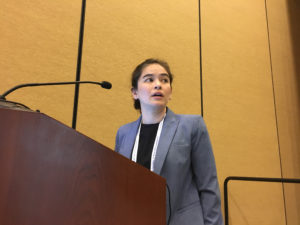The use of social media has increased dramatically over the past decade, with about 70 percent of U.S. adults using at least one social media site. Physician use of social media — especially professional use — is lower. Should physicians join the social media bandwagon? What’s in it for them and their patients?
Lisa Chan, M.D., M.S., Premier Anesthesiologists, and Roya Saffary, M.D., Clinical Assistant Professor, Anesthesiology, Perioperative and Pain Medicine at Stanford University, debated this question during Tuesday’s session “To Tweet or Not to Tweet — Chirps for Thought on Social Media.”

Roya Saffary, M.D., discusses the downside of social media and medicine.
Dr. Chan highlighted differences in the cultures of social media and medicine. Social media is characterized by openness, sharing, connection to many, crowdsourcing and transparency. In contrast, medicine is characterized by privacy, confidentiality, one-on-one interactions and the voice of one authority.
“Some of the social media characteristics are funneling into medicine,” said Dr. Chan.
Approximately 51 percent of people share their health care experiences online, 72 percent use online reviews as a first step toward finding a doctor and 80 percent search for health care information. Yet, 99 percent of health information online is created by nonphysicians.
Dr. Chan said physicians can be the “voice of correct information” online and can help to create a trusting bond by writing about how the latest health news affects people. She said that social media also can help physicians engage with patients, although she acknowledged that this area is controversial. Fewer than 5 percent of physicians use social media to provide thought leadership to patients.
Networking is another key benefit of social media, and some sites are designed specifically for physician networking, such as Sermo, Doximity and Student Dr. Network. LinkedIn and Twitter are more open networking sites but also can be of benefit to physicians, said Dr. Chan. Twitter, blogs and YouTube/Vimeo are the social media sites used professionally by most physicians. Keeping up with health care news is the leading reason physicians use social media, followed by engaging in discussions with their peers.
“Social media can broaden our reach, influence and relationships,” said Dr. Chan. Anesthesiologists can network with and lend simple expertise to colleagues in other areas of medicine. This networking can lead to collaborations on research and journal articles and invitations to blog or to speak at meetings and even job offers.
Dr. Chan challenged attendees to explore social media, to tweet at ANESTHESIOLOGY® 2018 and other medical meetings and to learn how their patients use social media for health care.
“Talk to them about what they found on social media. It’s one way you can connect with patients,” she said.
Dr. Saffary highlighted the negative patient-physician relationship side of social media.
“As an anesthesiologist, I have about five to 10 minutes to establish a relationship with a patient. I want that relationship to be based on what I say to the patient and my demeanor in that time period, not on anything I have posted on social media.”
She added that social media allows for direct physician-patient interaction without clearly set limitations and blurs the lines of professional relationships. In terms of using social media to educate patients, Dr. Saffary said that online educational content is abbreviated, generalized and does not provide sufficient background. Misinformation can have an impact on patients’ decision-making process and expectations regarding their medical condition.
Patient privacy is also an important issue, said Dr. Saffary. The use of social media platforms for patient-related concerns potentially results in a breach of confidentiality.
“Most social media platforms are not HIPAA-compliant,” she added. She encouraged attendees to learn about their institutions’ social media guidelines.
Both Dr. Chan and Dr. Saffary said physicians need to know how to deal with social media use by their patients, especially as the Millennial generation ages. Online reviews of physicians and health care facilities will only increase, and learning to manage professional images in light of such reviews requires thought and collaboration with risk management specialists.
Return to Archive Index